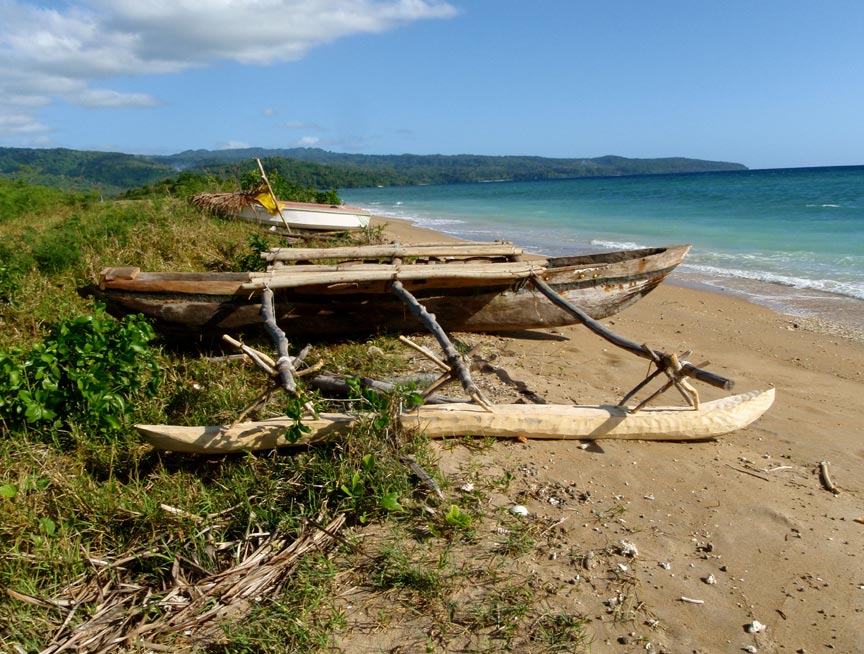Going Native - Lamen Bay, Epi Island, Vanuatu

Harmonie
Don and Anne Myers
Sat 26 Sep 2009 01:12
|
16:35.797S 168:09.805E
Epi Island is the logical next step when sailing
south through the Vanuatu Islands from Malakula to Efate where the capital, Port
Vila, is located. Epi lies almost due east from the south end of Malakula
and in a south/southeast wind like the one we had on September 14th, is easily
reachable by sail. The wind was lighter that day, so although we were
sailing close to it, we had a beautifully calm and mostly fast four hour sail to
Lamen Bay. Our stay there was brief - only a few hours - but more on
that later.
In the heyday of its colonization (the 1920's), Epi
was covered with coconut plantations and lorded over by the plantation
owners. The 1930's depression marked the end of Epi's
colonization prosperity and Epi has since been returned to the ni-Vans
for the most part. The village on Lamen Bay was surprisingly
prosperous. There was a road, an airport with a grass strip and tiny
one-room terminal, and a secondary boarding school for girls and boys that
services Epi as well as the surrounding islands. We went ashore for a walk
and ran into a contingent of the Vanuatu Army. They were visiting Epi on a
police/community outreach mission. One of the boy's dormitories had burned
down the month before - a boy was using a candle to read a book in
bed...luckily all the kids got out, but the building and everything in it was a
total loss. The Army was there to deliver replacement
supplies.
Chris, the twenty-something, very well-spoken,
handsome man in charge of the Army contingent explained that Epi, like most of
the outlying Vanuatu Islands, has no police force; so the Army is sometimes sent
out to the islands to do the work of the police as well as to help the local
chiefs resolve any disputes among the residents, etc. Chris seemed happy
with his work in the Army and glad to have had the chance to train in Australia,
but he admitted to being homesick for his village, which is located in the
Meskelyn Islands where we had just come from. If given the choice between
his current life living mainly in expensive Port Vila working for the Army, and
living off the land in his home village with his family, we got the impression
he would choose life in the village. This seems to be the dilemma here in
Vanuatu. The kids receive some level of education, a few move to the 'big
cities' to work where it is expensive to live and the pay low, and they end up
yearning to return to the simpler life of their villages - growing their own
food and living the good life dependent almost exclusively on nature.
After spending two months here last year and six weeks this
year, we've decided that what is typically viewed as 'progress' by the
western world (more substantial houses, TV, roads, cars, etc.), is not something
we'd like to see happen to Vanuatu. The simplicity of life in the outer
islands is so attractive, the people so content, we hate to think that it
could all be ruined by outside influence and too much stuff. We
definitely would not have felt this way two years ago. Amazing how a
little time living in close proximity to what we at one time would have referred
to as primitive people has changed our thinking about the way they
live. Please don't worry! This doesn't mean that we plan to
jump ship and move into a hut with the natives, it just means that we have
a new appreciation for the way the other half lives.
After our pleasant walk down the airstrip (no
security fences here!) and through the village, John and Sue and Don and I
jumped back in the dinghy and zipped back to the boats. This was not
an easy feat because the swell had picked up in the bay and we all got
soaked to the waist trying to scramble in the dinghy sack-of-potatoes style
as the surf pushed us around. Ahhhh...the joys of boating. The
increased swell in the bay was also causing the boats to roll rather
dramatically. We had planned to leave Lamen Bay very early the next
morning for the final trek south to Efate Island, but after another
look at the weather, we decided it didn't make sense to spend a sleepless
night rolling around in the bay when we could take advantage of the
extremely light winds (no good wind predicted for days) and clear skies and
motor through the night to Efate. So that's what we did. At about
8pm that night, we pulled up anchor and headed south with Storyteller.
More on that later.
Picture 1 - This is Lamen Bay - another white sand
beach around a perfectly formed bay. This bay is famous for the
dugongs (manatees) and giant sea turtles that live here. We did see a
dugong floating on the surface and a giant turtle's head poking up, but neither
stuck around long enough to get their pictures taken. The thing to do here
is to swim with the dugongs (they are very friendly and supposedly like to have
their tummies rubbed). However, given that these beasts are quite large (not
hundreds, but thousands of pounds), none of us really relished the idea of
getting in the water with them.
Picture 2 - A villager's canoe and
fishing boat high and dry on the sand near the airstrip.
Anne
|

